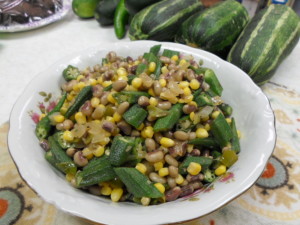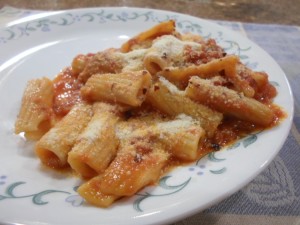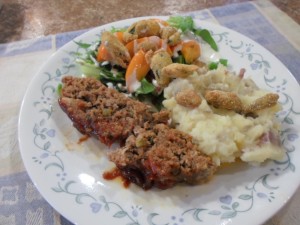It’s interesting the way certain events help form our opinions. When in my early teens, I spent a summer in Houston. While its hospitals saved my life, I did not develop a fondness for the city. Likewise, I had a bad opinion of succotash related to that experience.
Every evening patients filled out a slip with their meal requests for the next day. Every day I chose the vegetable notated with the number 7, which was corn. Patients just wrote the number of their selections on the slip, not the name of the items. Each day I received succotash, not corn.
My mother never made succotash and I wasn’t familiar with it. What I really wanted was just plain corn. I’m not complainin’, I’m just sayin’. Turns out that the menu duplicated number 7 and it was also an option for succotash.
I understand that succotash is a Native American dish made with corn, vegetables and usually lima beans. I read that other beans may be substituted for lima and decided that black-eyed peas would be a good alternative. Yes, I still have black-eyed peas in the freezer from last year’s crop.
Succotash
2 Tbsp. olive oil
1 small onion, chopped
2 mild peppers, chopped
1 clove garlic, minced
2 c. okra, chopped
2 c. corn
2 c. black-eyed peas, cooked
2 Tbsp. sugar
1/4 c. red wine vinegar
1/4 c. fresh herbs like parsley or basil, chopped
Salt and pepper, to taste
Heat oil in a skillet and sauté onions, pepper garlic and okra. Season with salt and pepper. Cook about 10 minutes until the onions are translucent and the okra is tender. Add corn and black-eyed peas and cook until warmed.
Mix together sugar, vinegar and herbs. Pour over vegetables and toss. Taste and adjust seasonings. Serve warm or chilled. I’m starting to change my opinion of succotash.
I have an abundance of zucchini squash and could have used it in the succotash instead of the okra. However, I saved it for the following dish.
Squash Medley
3 lbs. squash, chopped
1 onion, diced
1 clove garlic, minced
1 Tbsp. olive oil
1 Tbsp. butter
1 c. corn
1 can diced tomatoes
2 tsp. corn starch
1 tsp. dried oregano
1 tsp. dried basil
Salt and pepper, to taste
Topping:
1 c. bread crumbs
1/2 c. Parmesan cheese
1 Tbsp. dried parsley
2 Tbsp. melted butter
Blanch squash and drain in a colander. Sauté onion and garlic in butter and olive oil. Add corn and most of the tomatoes, mixing cornstarch into the remainder and then adding to the pan. Cook until it begins to thicken and then add herbs, salt and pepper.
Pour into a greased casserole dish. Mix together the topping ingredients, making a crumble and sprinkle over the top of the casserole. Bake at 350 degrees until bubbly.




